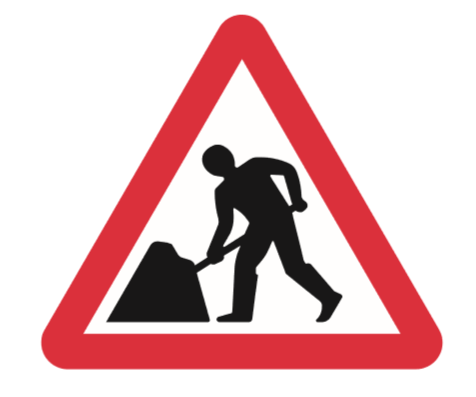Signing of the works
It is important that the distances, including safety zone dimensions are determined before starting to set the signs out. From the table in the setting out site section of this Code select the size and distance for the advance signs. The basic site layout for works on a single carriageway road with a works vehicle present is shown in the Coned area section of this Code. If there is limited visibility on the approach to the proposed works site, e.g. on a bend, on a dip in the road, or on the brow of a hill, you must provide extra advance signs. These extra signs will need to be placed first.
Where there is a grass verge the signs should normally be placed there. Placing signs in the footway is permitted, but they must be positioned so as to minimise inconvenience or hazard to pedestrians, with particular consideration given to those with visual impairments, pushchairs, wheelchairs and mobility scooters. A minimum usable footway width of 1.5 metres should be maintained where possible. See the Footway and footpath works section of this Code for details.
The lower edge of all signs should be no less than 300 mm from ground level, and care should be taken that signs are level, particularly if the ground is uneven.
Warning: In no circumstances must the footway width be reduced below 1.0 metres. Where the minimum footway width of 1.0 m cannot be maintained, you must consult your supervisor, manager or other competent person.
Caution: Consult your supervisor, manager or other competent person if the works are going to make it impossible for drivers to comply with a permanent traffic sign. Such signs might need to be covered or relocated; the highway authority must be consulted before this is done.


Traffic control warning signs – include advance signing for any traffic control systems in use.
On roads with speed limits of 50 mph or more, the above advance signs should have supplementary distance plates giving the distance to the works in yards or miles (not metres).

Warning: Do not place ‘Keep left’ or ‘Keep right’ sign frames on their sides to make them point in the correct direction, as this could cause a hazard to road and footway users, and may cause confusion. These signs must not be used for directing pedestrians.
Advance signs should be placed so that they:
- are in the correct sequence;
- are within the correct distances as shown in table inside back cover;
- can be clearly seen;
- cause minimum inconvenience to road and footway users;
- are at a minimum risk of being struck by vehicles; and
- cannot be obscured by parked vehicles.
Fixing of signing, lighting and guarding
Signing, lighting and guarding equipment must be fixed to prevent it being blown over or out of position by wind or passing vehicles. The use of equipment with built-in weights is recommended. Alternatively you may add appropriate weights e.g. sacks containing suitable granular material placed at low level.
Warning: Do not use barrels, kerbstones, spoil, road pins or similar objects for the purpose of weighting or securing road signs and barriers – they could create a danger for highway users if struck by a vehicle.
Additional requirements
Sometimes you might have to duplicate the warning signs on both sides of the road. An example of this would be where signs on the left-hand side become obscured by heavy traffic. On dual carriageway roads, the warning signs may need to be duplicated in the central reservation – consult your supervisor, manager or other competent person.
Warning: You should only cross a live carriageway on foot when traffic flows are low enough to regularly produce sufficient gaps between vehicles to allow time to cross safely. For dual carriageways, the need to place signs in the central reservation must be assessed before you proceed and you should consult your supervisor, manager or other competent person.
The road width and volume of traffic at the works site might make traffic control necessary. See the Traffic control section of this Code for details of which type of control is appropriate.
Signs should be set out for traffic approaching from all directions. Before any works equipment is placed in the carriageway, advance signing must be provided. (For exceptions associated with works between parked vehicles see the Works on single carriageway roads section of this Code).
If you place a pedestrian walkway in the carriageway, or create obstructions such as spoil or plant outside the working space, sign, light and guard them separately, and to the same standard.
